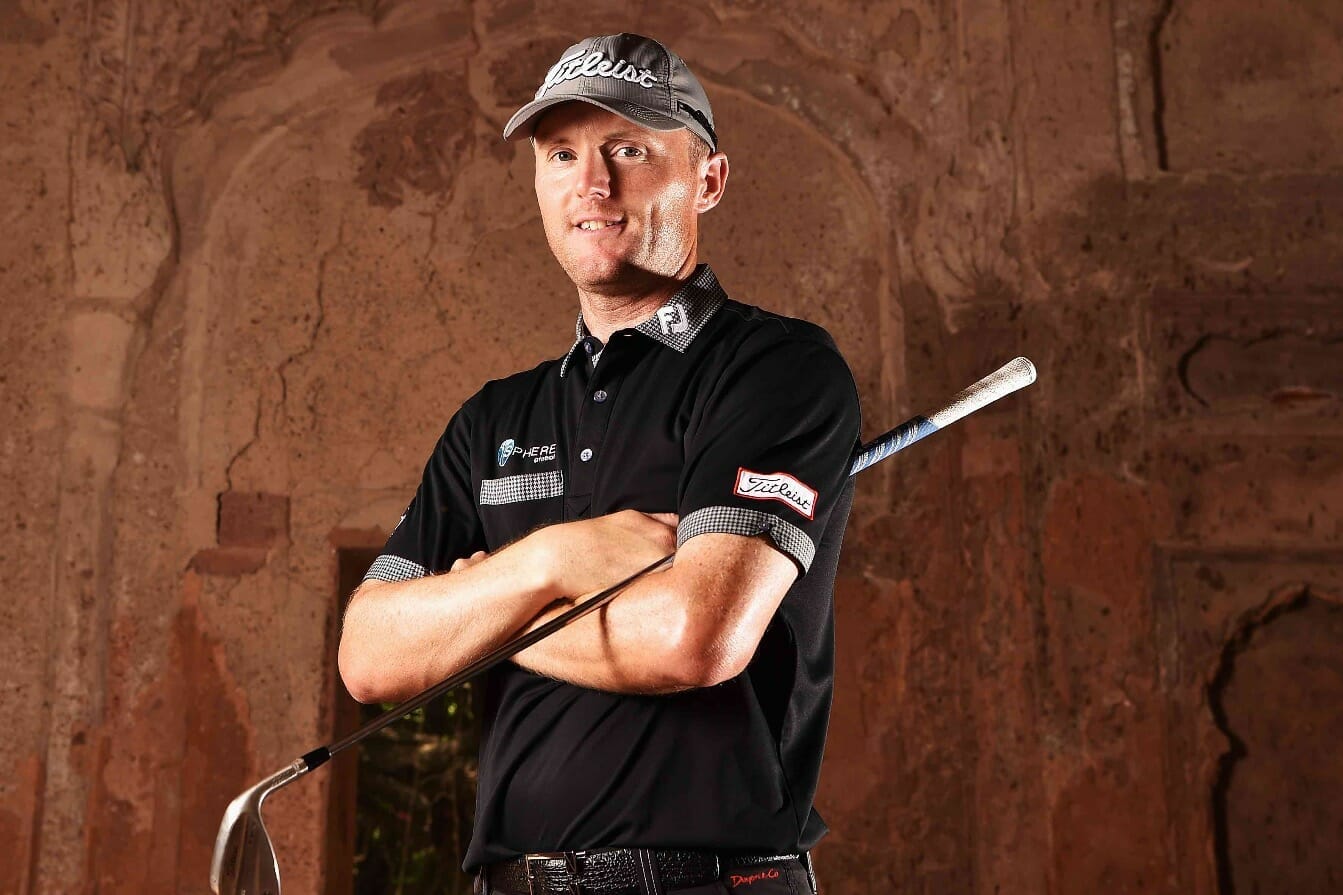When Irish Golfer Magazine catches up with Michael Hoey it’s just as he is leaving the house for a spell of warm weather training in Spain. By his own admission, he has had enough of living in the ‘real world’ and is itching to get back on to a golf course.
Michael finished T18 on the European Tour in Kenya last week but before that his last official tour start was a missed cut at the Australian PGA Championship way back at the beginning of December and since then he had been fully employed in ‘crowd control’ helping his wife Bev look after his two young children – Calum and Erin.
“They don’t want to use the wee clubs that are the right size, they want to use dad’s clubs,” he says.
“They had my brand new driver out the other day. I love it, and they were whacking it and then one of them throws a golf ball at you but they don’t realise just how hard the things are!”
As he embarks on his 16th year as a professional, Michael remains committed to the sport and engrossed in his job but he’s more aware than ever of the harsh realities facing professional golfers in the lower reaches of the game.
“I’m putting more into it now than I have done in years,” insists the 39-year-old who is fit and healthy after shaking off a lower back problem that hampered him through the summer last year.
“I’m hitting balls 100 per cent pain free and I’m really happy about that because it was really annoying me,” he added.
“I couldn’t swing freely, it was always tight but I went down and saw physio Shane Lawlor and he’s world class. Hopefully that’s me fit and ready to go now.”
“I still love the competition but professional golf is difficult and making money at it is the problem. The scoring is just so good now. Some weeks on tour the leaders are reaching 25 under which is incredible.”

Michael Hoey / Image from Getty Images
After turning professional in 2002, Michael struggled to find his feet until finally becoming a fixture on the European Tour from 2009 to 2016. He collected five wins in that period, the biggest of which was the Alfred Dunhill Championship in 2011.
He was often inconsistent but when he got into a winning position, he had an uncanny knack of getting the job done.
He dropped down onto the Challenge Tour last year and will once again be plying his trade with the young guns in 2018.
“I quite enjoyed most of 2017 but I didn’t enjoy the lack of money,” he says. “I like the friendly atmosphere around the Challenge Tour. There’s less clutter, fewer managers, agents and reps around. You just get to the venue and play golf so it’s quite pure in that regard.”
“But it is tough going. You work hard, play well in some events and finish 11th, 12th, 13th and you walk away with €3,000 or €4,000. That just about pays for your expenses and you’ve played pretty well.”
“I actually had my lowest ever stroke average last year and I was quite consistent but I just didn’t go low enough when I needed to.”
Michael’s role as tournament ambassador with the NI Open at Galgorm Castle has given him a insight into the low-scoring mindset on the Challenge Tour but the week-to-week aggressive on-course approach of the players has given him pause for thought.
He continues; “There are so many players around the same mark these days and that is why cuts are so high. You can sometimes have 30 people on the same score. When I started 10, 15 years ago you would have had eight to 10 people on the same score. The cuts are so deep now.”
“The standard is just so good. Yes, the courses are pretty straight forward but it is ridiculously low scoring. It seems that every day someone shots 10 under par so you have got to be able to putt, but I guess it is the same for everyone in the field.”
“You have to be dialled in with the short irons. Know exactly how far you hit them and then you have to be able to score. Driver accuracy isn’t as important as driver length.”
“I have seen so many guys on Challenge Tour hit a really bad tee shot but still walk away with birdie. On the main tour you will be punished more often.”
As a result, Michael has been working hard on his putting at his indoor facility at home. While the snow and rain has kept him off the course, he has still been able to practice and fine tune.
“I can hit putts of up to 30 feet at home. It has some slopes and some flat areas. I installed it nearly three years ago and it has worked out really well,” added Michael who is currently coached by Seamus Duffy.
“It’s stimping at 10.5, so it is really, really good for seeing what you are doing with the putting. I’ve a chipping area as well, off synthetic turf and there’s an area for hitting full shots into a net.”
“It’s been a very good investment. Chris Selfridge comes up regularly for a bit of competition. You need that when you are putting, you need to be playing for something. Pride, or a few pounds here or there. We have had some good contests and I think my putting is a lot better now. I’m looking forward to seeing how it feels out on the course.”
He’s also been hitting gym with one eye on extending his career. “I spoke to some of the physio guys at the end of last year about what I needed to do to stay competitive in my late 30s,” added Michael.
“They encouraged me to lift some weights because you need to keep your testosterone levels up especially when you are over 30.”
While he feels that things are in a good place physically and technically, he admits there is still room for improvement in his approach to how he plays the game.
“On a Thursday you have to go for it from the start and be aggressive. Even making the cut is a waste of time because the money is so top heavy. You have to change your thinking and go for it and that is difficult.”
“I have always had an attitude about playing my way into a round and finding some rhythm, not taking shots on until you have strung a few pars together.”
“Last year, there was only four weeks on tour when the winning total was less than 16 under. How can you possibly play your way into a round by stringing a few pars together? That doesn’t work now. I tend to agree with the theory about how growing up on tough links course at home doesn’t help you as a professional. It is a birdie festival now and one under par isn’t a good score anymore. The cut in Turkey was five under last year!”
Michael finished tied seventh in his opening competitive event of 2018 on the Ecco Tour in Spain, before unfortunately missing the cut at another Ecco Tour event five days later. It was however a useful exercise and one that gave him some pointers as he looks ahead to what could be a defining opening tournament on the Challenge Tour – the Barclays Kenya Open from March 22-25.
“Our very first event of the year is the biggest with €500,000 on the line,” he says. “It is the 50th Anniversary and with that prize fund it is a major for us. Basically, whoever wins the first event of the season is more or less guaranteed a tour card next season that’s one of the reasons why I am playing on the mini-tours because I need to be ready to go.”
“It is a bit unfair to be honest to have such a big event so early in the season. It would have been far better to have two tournaments but I guess that’s the way it goes.”
“There will be a lot of interest and a top five or top 10 finish will have a significant impact on the season.”
This article appeared in the March edition of Irish Golfer Magazine
On encouraging his children to consider tour golf as a career
I have spoken to Johnny Foster about this a lot.
It is an incredibly lonely existence but people don’t see that.
You might travel with people, but you are on your own because you are competing against each other.
Team sports are very healthy. Certainly, I think try that first before you see if you fancy the lonely lifestyle.
I’m a bit of a loner. I don’t mind my own company but there are not many people who are suited to that. It’s not really that healthy.
People see the glitz and glam of Jon Rahm and Rory McIlroy making 50 million a year. If you can make that money, you can bring an entourage with you.
Unless you are at that very high level you don’t really make enough money to bring a team with you which makes it a lonely life.
On opportunities for players progressing from Challenge Tour or Q-School
I’m still on the [players] committee and we are talking about categories because it is not good.
I go to the meetings because I enjoy them and I try to offer some input.
If you won the Challenge Tour last year you didn’t get into the Desert Swing events which is really, really bad. You are not getting rewarded for winning the Challenge Tour.
Paul Lawrie just got in via his ranking on the career money list.
Q-school is close to being a waste of time. You want to get through it, you want to get a card but you are just not getting enough playing opportunities and we talk a lot about that at committee.
In a way, I was a bit relieved to not get through Q-School because it could have been another year wasted. It sounds a bit messed up, but I have more opportunities on the Challenge Tour than I have with hardly any starts on the European Tour.























Leave a comment